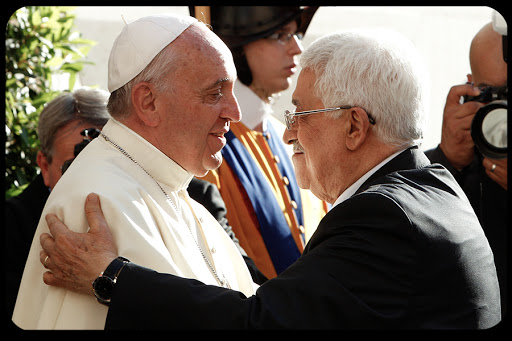This week Pope Francis found himself in yet another media firestorm. Did he really say that Palestinians leader Mahmoud Abbas was “an angel of peace”? CNN clarifies the controversy here. It turns out the Pope gave Abbas a commemorative medal just as he does other visiting politicians. On the medal is an angel of peace and, in explaining the medal, the pope encouraged Abbas (as he encourages other politicians) to be “an angel of peace.”
The misunderstanding unlocks a greater problem with Francis’ papacy. In many ways it cannot be denied that Francis’ papacy is divisive. His actions and words are misunderstood so often that we must ask why the problem occurs and what can be done about it. Some of it has to do with Francis’ informal, off the cuff style. He would rather risk some misunderstanding than to be hedged about with so many restrictions that he cannot speak from the heart.
However, there are several factors that contribute to the problem which are no fault of Pope Francis’. First we have the language barrier. The Pope usually communicates in Italian or Spanish. Subtleties of subtext and connotation are invariably lost in translation. Not only must the Italian and Spanish be translated into English, but the words are translated into every global tongue. To complicate matters further, with instant global communications the words are no sooner out of the Pontiff’s mouth than they are splashed across the world’s headlines. Public figures have never had to cope with such constant accessibility and instant communication. The third essential problem is the cultural barrier. The Pope is from Argentina. Like every pope before him, he brings his own worldview, personal history and cultural background to the papacy. It is impossible for everyone to understand the full context of his communications because it is impossible for everyone to understand what it means to be an Argentinian.
Communication is a two-way street, and in addition to the linguistic, media and cultural difficulties every public figure experiences, one must also consider the person who is receiving the communications. Every communication is filtered through the ears and eyes of the person receiving the message. Whatever Pope Francis says, therefore, will be perceived in a different way depending on each person’s personal background and bias.
Consequently, a North American progressive may very honestly perceive Pope Francis as a typical pro-gay, socialist left winger while a social conservative may see Pope Francis as a strong anti-abortion, pro-family traditional Catholic leader. In other words, those receiving the message may only hear the message they want to hear. When Pope Francis turns out to be opposed to same-sex marriage and women’s ordination the progressive will either block out the message or devise some trick to pretend it is not really Pope Francis speaking.
Likewise, the social conservative might hear that Pope Francis seems to oppose capitalism, is open to helping divorced and re-married Catholics, and says he is not the one to judge people with same-sex attraction, and become upset because the Pope challenges his pre-conceived ideas.
Finally, Pope Francis—like every public figure—has to deal with the humiliation of having his words and actions dissected and deliberately misinterpreted by the world’s press. The mainstream journalists on Vatican duty rarely have enough education in Catholic matters to report accurately, and when they do, too often their reporting is biased. They are selective in what they report, slant the stories to cater to their editor’s political viewpoint and often miss the point of both the Pope’s actions and the overall priorities and perspectives of the Catholic Church.
Therefore, here are some guidelines to avoid misunderstanding Pope Francis. First of all, don’t believe the headlines. Headlines are designed to grab your attention, not to communicate the story accurately. Don’t believe the website headlines. Don’t believe the blog headlines. Don’t believe the Facebook headlines. Don’t believe the newspaper headlines.
Secondly, try to get your news about the Catholic church from reliable Catholic news sources like Aleteia, Catholic News Service and ZENIT. These online sources may not be as exciting as sensational blogs, salacious Facebook stories or tabloid gossip, but they will use reporters who understand Pope Francis and the mission of the Catholic Church.
Thirdly, make a real attempt to get to know Pope Francis as he really is—not as the media presents him. There are plenty of good biographies on Francis and plenty of good books with his speeches, homilies and writings. Try to understand his cultural, religious and political background. Take time to understand how the turmoil of events in Argentina during his lifetime have formed his spirituality, his teaching and his pastoral role in the church. Most of all, get to know him as the shepherd of souls, the compassionate pastor and the loving Holy Father. Remember who he is and who God has called him to be.
Finally, remember to really pray for Pope Francis. As you do you will come to understand him in the deepest and truest way. The Holy Spirit will show you how to understand Pope Francis and why he has been chosen at this time to lead Christ’s Church on earth.
Read Fr Longenecker’s blog, browse his books and be in touch at dwightlongenecker.com

